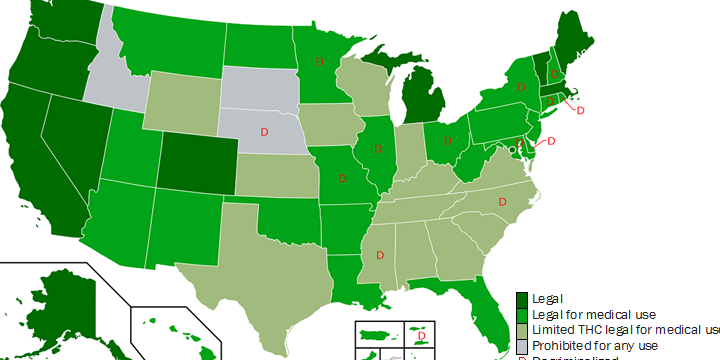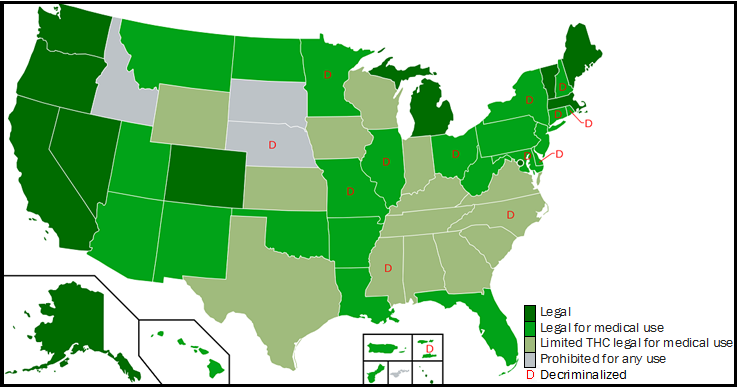
Cannabis farming: utilities have power to make growing industry more energy efficient
The cannabis industry is going through a change, we are amid a wave of legality. Cannabis is now legal in some form in most states and territories in America. As a result, legal cannabis production is a booming emerging industry with rapid expansion and large energy needs.
With many opportunities available for growers to save energy, the time is right for utilities to take an interest. Whether it is trying to encourage more greenhouse facilities or offering ways to make indoor grow facilities more efficient, there are many ways to save. By developing programs specifically for the cannabis industry, a targeted approach will lead to large electricity savings and a more efficient industry.

Source: Lokal_Profil CC BY-SA 2.5; Data obtained from National Conference of State Legislatures
Cannabis for both recreational and medical drug usage is the most energy-intensive agricultural crop in the United States. The energy estimates for cannabis cultivation range from 6 – 580 kWh/kg for greenhouse cultivation, and 4,400 – 6,100 kWh/kg for indoor cultivation. The growth and production methodology and efficiency have been largely unmeasured and unexplored due to the historically illicit nature and secrecy of the crop’s growth.
As new production comes online, it offers utilities an avenue for offering savings and a chance to aid an underserved developing industry in becoming more efficient. Promoting initiatives and finding areas to save energy will be key in the next few years as new facilities start and make large financial choices about their building and the technologies they purchase. Many of these technologies have long useful lives and choices now will affect their energy usage for many years to come. Understanding the market and the grower’s needs are integral when offering rebates and incentives to influence purchases.
The state of Washington researched the different growth methods of the legal cannabis cultivation and found 60 percent is indoors, 10 percent is greenhouse and 30 percent is outdoor cultivation. The different growth methods have varying energy usages and operating periods. Indoor cultivators will operate year-round and are the most energy intensive, with 150 W/ft² of active canopy. Greenhouse cultivators operate 30 percent to 50 percent of the year with energy consumption of 60 W/ft² of active canopy. Outdoor cultivators typically have little to no energy consumption, unless supplemental lighting is used.
With indoor growing being the most prevalent and the most energy intensive, it makes sense for utilities to address how the energy is being used. Indoor growing can have low-energy costs, if the only equipment is efficient lighting and it is used in a low-density pattern. However, the ideal environment is bright, dry, warm (~70-80°F), CO2 rich, and with circulated air. High-intensity discharge lamps are prevalent due to the brightness and direct heat they provide. But, large discharge lamps in an enclosed space necessitates supplemental cooling to achieve the ideal environmental temperature. This means air conditioning is needed to counteract the heat provided by the lamps. A CO2 rich environment can be achieved by using a burner carbon dioxide generator, which could be from burning propane or natural gas. Other energy-intensive items used are dehumidifiers, room fans, in-line duct fans, water pumps, water purifiers, water heaters, ozone generators and powered carbon air filters.
Typically, one third to one half of the indoor cultivation energy use is from lighting. This presents a large and easily accessible opportunity to provide savings. Usage of grow lights is across four major categories: high-intensity discharge (HID), fluorescent, induction and light-emitting diode (LED) lights. Some utilities will only provide rebates for a conversion or installation of LED lights. By only offering the most extreme conversion option (HID to LED), it can dissuade customers from participating. With some distrust and wariness for LEDs in the growers’ market, an LED-only option would never be considered by some customers. A better strategy is to offer a tiered approach where a lower incentive would be available for other lights, like ceramic metal halide. As lower wattage per square foot lighting is used, it will decrease the amount of air conditioning needed to keep the plants at optimal temperature. Incentives can be offered for the reduction in light wattage and also air conditioning.
The second largest energy user within a grow facility is typically the dehumidification and ventilation. It can be an overlooked area of energy savings when designing a facility. When residential dehumidifiers are used, they can have inefficient operating ranges from two liters of water per kWh (minimum for ENERGY STAR® rating, but lower efficiency models are available). By purchasing and installing a traditional commercial dehumidifier, this can increase to 4.2 liters of water per kWh. Research from the Western Cooling Efficiency Center – University of California-Davis has shown that even larger energy savings are possible depending on the choice of dehumidification system. Traditional dehumidifiers deposit excess heat back in to the facility, causing inefficiency and additional work for the air conditioner. By using a dehumidification system that is designed to not add heat to the facility, they found energy savings could range from 30 percent to 65 percent. Incentives can be offered for higher efficiency dehumidifiers, and larger incentives when implementing a whole-facility dehumidification and conditioning strategy.
In addition to allowing indoor grow facilities, the law in several states also allows for outdoor and greenhouse growing of cannabis. Using sunlight with supplemental lighting greatly reduces the overall energy consumption of a facility. By providing incentives for greenhouse growers, it could stimulate a greater shift towards greenhouses instead of indoor growing. Incentives could be for infrared polyethylene greenhouse covers, which absorb and retain infrared energy which maintains a higher greenhouse temperature overnight. A greenhouse controller can also be incentivized and implemented to automate the CO2 generation, dehumidifiers and the temperature. Additional incentives can be offered for piping insulation and thermal curtains.
Slipstream wants to be your partner. We are here to help you design a program offering to support this new industry. Contact me to discuss next steps.